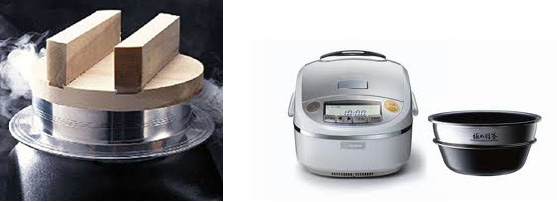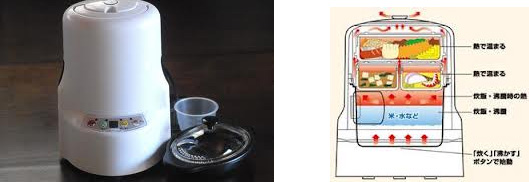Because of the expansion of food globalization, rice consumption in Japan has been on the decrease. However, since rice is our staple food, every one of us feels comfortable when we have freshly cooked rice and miso soup. Naturally, since we eat it daily, our desire to have better rice grows.
From the standpoint of most Japanese people, delicious rice is as such: when cooked, every grain of rice looks glossy and plump and when consumed, slightly sweet and moderately sticky and elastic.

In the old days people used to put rice and water into a metal pot called hagama, cover it with a wooden lid and place the cooker on the furnace and cook it with a wood fire. A finely balanced heat control was necessary to produce delicious rice, so they didn’t leave the kitchen while cooking, and the room must have been filled with savory aroma of cooked rice.
After the post-war high-growth period, electric and gas rice cookers became widespread. Electric cookers, especially, have developed rapidly. It takes time and effort to make delicious rice, so home appliance manufacturers have studied the structures of the furnace and pot, developing appliances which operate on the same principles as the old method. Thanks to the electric rice cookers incorporating automatic timers and warmers, people are able to cook rice whenever they want, and eat hot rice any time.
In recent years, the trend of slow food and experience of blackout due to the 2011 earthquake have pushed us to utilize methods of cooking rice without depending on electricity. One of those methods is cooking rice using an earthen pot on the stove, while others love to use brand-name pots like Staub; all claim their method cooks rice better than electric cookers. I think those who adhere to having delicious rice tend to choose not to use an electric rice cooker.

Amongst the latest rice cookers, there is a unique one – an electric lunch box containing a rice cooker – useful for those who live alone. You just put the container with the rice and water on the electric heater, stack the other containers with dishes and miso soup on the rice container, then cover. During the cooking time of 40 minutes, the dishes and soup are heated as well as the rice, so when the rice is done, you have a complete hot meal! Freshly cooked meal is always the best.
Reported by Yukari Aoike, Sugahara Institute
